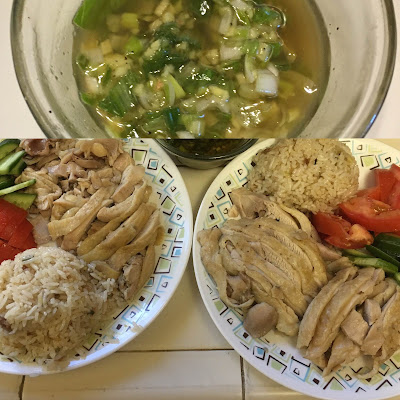I. Italian Sponge Cake (歐式海綿蛋糕)
- [Prep Work] Take 6 eggs out of fridge, and leave them in room temperature for 30 minutes. Line the bottom of a 9" x 13" baking pan with parchment paper (bottom only). Now, separate 6 egg whites from egg yolks (place egg yolks into a small mixing bowl, and egg whites into the bowl of a Stand Mixer). Note- Consult this YouTube Video for more info on separating egg whites.
- Add 1/4 cup of milk, 1/4 cup of veggie oil into the mixing bowl with yolks. Whisk vigorously for 1-2 minutes (with a balloon-shaped whisk).
- Sift 1/2 cup of all-purpose flour (with a strainer) into the mixing bowl with yolks. Whisk vigorously until there is no clumps at all in the mixture (2-3 minutes).
- [Whip Egg Whites to Stiff Peaks] Turn on Stand Mixer (using a Wire Whip), at low speed (Level 2-3 out of max-10), till the egg whites start to bubble, then to foam (1-2 minutes). [Optionally, but preferably,] add 1/2 tsp of Cream of Tartar. Start to gradually add 1/2 cup of sugar (1/3 cup, if you're sugar conscious:-). Now, increase Mixer speed to 8 (max-10), if you want to speed up things a bit, till the egg whites show stiff peaks (~1.5 - 2 minutes, stop the mixer every 30 seconds or so, to check on the stiffness of egg whites with a spoon). Note- Whipping to Soft-to-Medium Peaks works equally well. Cream of tartar helps in stabilizing the whipped egg whites in the baking process. Consult this YouTube Video for more info on separating and whipping egg whites.
- Scoop ~1/4 - 1/3 of the whipped egg white into the mixing bowl with egg yolks and flour (Step 3). Stir and mix thoroughly (with a silicone spatula).
- Scoop all the mixture from Step 5 into the Mixer bowl with the whipped egg white (from Step 4). Use a silicone spatula to gently fold the egg whites up from the bottom of the bowl, to mix the whipped egg white with the egg yolk-flour mixture. Gently fold, in broad motions, until thoroughly mixed.
- As part of the Prep Work in Step 1, we've lined the bottom of a 9" x 13" baking pan with parchment paper (bottom only). Pour the batter (from Step 6) into the baking pan. Gently spread the batter to the four corners of the pan and even the surface level. Shake the pan horizontally a few times to further even the surface. Now find a solid wooden surface (like that of a solid dining table). Tap the bottom of the pan on the wooden surface a few times (i.e., bring the pan up 2-3" from the wooden surface and pound the pan down on the surface), to even the surface level and rid the air bubbles in the batter.
- Preheat oven to 250-degF, place the 9" x 13" baking pan in the oven (on the bottom rack), and bake till the surface turns slight golden (~20 - 25 minutes). Increase the oven temperature to 300-degF, and bake till the surface is golden brown and an inserted toothpick comes out clean (~10 -15 minutes after setting the temperature to 300-degF). Cover the top of the cake pan with aluminum foil when the cake surface reaches the desired color.
- Take the pan out. Let the cake cool for 5 minutes. Loosen the four sides of the cake (with a plastic knife if it's a non-stick pan), then flip the sheet of cake out onto parchment paper (i.e., to cover the baking pan with a cutting board that's covered with parchment paper, and then flip the baking pan onto the cutting board). The cake is now bottom side up. Remove the parchment paper that was placed at the bottom of the baking pan previously (now attached to the bottom of the cake facing up). Let cool for 5 minutes.
- (Continue from Step 9 above) Roll the cake up tightly with the parchment paper underneath, like doing a sushi roll (see either one of the two excellent YouTube videos cited above for details).
- Tighten both ends of the parchment paper, and leave the roll in fridge for 30 minutes or longer. Cut and serve. This cake remains fresh in the fridge under plastic wrap for 3-4 days, but not much longer. To increase shelf life to 7-8 days, leave the cake in the oven for 15-20 minutes after turning the oven off (this makes the cake slightly drier). Here is the outcome from our kitchen.



























